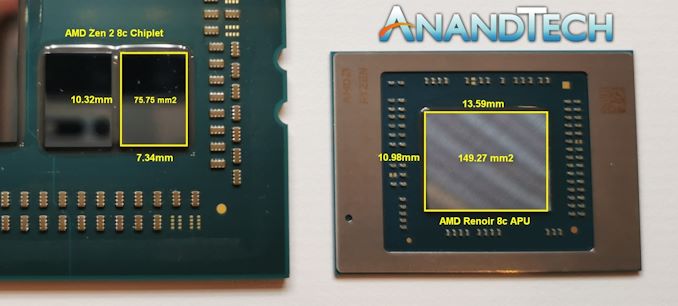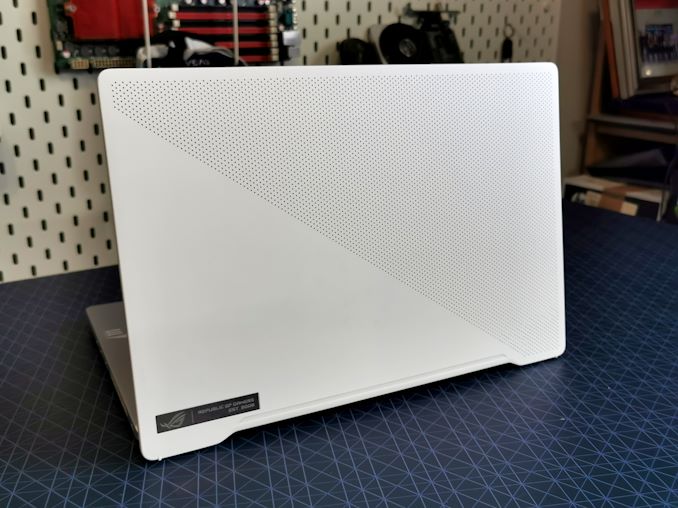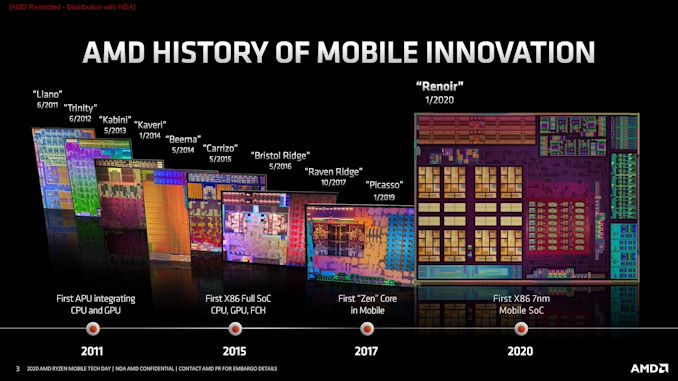AMD’s Mobile Revival: Redefining the Notebook Business with the Ryzen 9 4900HS (A Review)
by Dr. Ian Cutress on April 9, 2020 9:00 AM ESTConclusions
It is easy to get caught up in the hype. A vendor that has had a number of recent successes comes along, shouting from the rooftops about a new product. The fact that they’ve had recent success buoys the immediate confidence, but it’s in a product area which they’ve had historically poor performance in, and it’s clear that in the past the segment has needed a push.

AMD CEO Dr. Lisa Su with a Ryzen Mobile 4000 Notebook (CES 2020)
With the Ryzen Mobile 4000 series, AMD is promising at least parity with the competition, if not outright dominance. But it’s a segment that also requires OEM support. Out of the gate AMD, partnering with ASUS, Lenovo, and Dell, are listing some high quality devices with promises of performance and parity. Offering up to eight cores for 15 W along with improved graphics, then 45 W processors in system designs that weren’t previously seen in the market, is a very compelling offer. To that end, we’ve tested one of the best examples of AMD’s new hardware, in the ASUS Zephyrus G14, a 14-inch mobile powerhouse that looks like an ultraportable, but isn’t as bulky as a traditional high-throughput machine.
Inside the Zephyrus G14 is AMD’s Ryzen 9 4900 HS, a 35 W variant of the 4900H, with eight Zen 2 cores, and it was paired with a GeForce RTX 2060 Max-Q, given that these sorts of processors are often paired with discrete graphics, and ASUS went down the NVIDIA route with this design. The monitor is a 1080p 120 Hz adaptive refresh display, with the system offering 16 GB of DDR4-3200, a 1 TB Intel 660p NVMe SSD, and an Intel Wi-Fi 6 solution. Users can charge the 76 Wh battery either by a bundled 180 W power supply, or a 65 W Type-C connection. ASUS is set to sell this configuration for $1449, which is a super price given the specifications.
Our comparison point was a slightly more expensive Razer Blade 15-inch, which offered a 6-core Intel processor with essentially the same GPU, a high refresh rate 1080p display, and almost near parity on the rest of the internals. This review has covered two parts – the processor and the notebook.
The AMD Ryzen 9 4900HS
One could argue that with the upcoming consoles each having eight Zen 2 cores inside with integrated graphics, one of the best pieces of hardware to have for gaming would be a chip with eight Zen 2 cores and integrated graphics. The Ryzen 9 4900HS in our device is lower power, but in the G14 it packs quite a punch. In our CPU tests we saw a single thread lead over the i7-9750H, even though the i7-9750H advertises a higher single core turbo speed, and the multithreaded tests were easily on AMD’s side, offering more cores and a better instruction throughput per clock.
For gaming, we are still in a hit and miss stage – most of our benchmarks with the RTX 2060 were on the boundary of switching between CPU and GPU limited, and in the older simpler tests (like CS:S) Intel pulled ahead. Intel also won on Civilization 6, both the GPU and the AI test. On the newer tests, like Borderlands 3 and Final Fantasy 15, the AMD CPU was ahead. This all turned on its head however, when we looked at on-battery power saver performance, which put AMD ahead across the board. At that lower power, AMD was driving a better CPU/GPU performance balance compared to our Intel system.
In our hardware tests, we saw that the core-to-core latency inside a Renoir CCX is actually a few nanoseconds quicker than with Intel’s ring (17-18 vs 19-21), however going between CCXes comes with a penalty. That penalty is lower than a desktop Matisse processor because we don’t have to travel off-die to go between the CCXes. What was perhaps surprising is our ramp clock test – AMD is able to go from idle (1.4 GHz) to turbo (4.4 GHz) in just under 20 milliseconds, or one frame at 60 Hz. Compared to our Intel chip, which took ~40 milliseconds to go from idle to turbo (1.1 GHz to 4.1 GHz) but then another 40 milliseconds to jump up another 100 MHz. This should imply that AMD’s system can be more responsive, but not only that, AMD’s system went +100 MHz above the advertised turbo, whereas the Intel system was actually -300 MHz down.
Even though this device has a discrete GPU, we tried the integrated GPU, which AMD promised is a super-improved Vega8 design with higher frequency (1750 MHz) and better memory (DDR4-3200). They’re not wrong – it trashed our 3500U system which also has Vega8 graphics (1200 MHz and DDR4-2400).
On the memory side, we put in a stick of 32 GB DDR4-2666, and saw that our gaming tests took a nose dive. It looks like this is a system that really likes memory frequency, which is going to be important when the desktop variants hit the market. It also means users that are looking at the cheaper Ryzen Mobile 4000 devices should be wary of what memory configuration they are getting.
The ASUS Zephyrus G14
I think we can all agree that when we get access a nice laptop, one that doesn’t delay or falter or need any kind of babysitting to get right, it is a dream. This is what ASUS has tried to do with the G14. It has a really appealing design, as is clear by how many awards it was given at CES, and as mentioned above, it is a lot slimmer than the image that appears mentally when you hear the words ‘8-core CPU with RTX 2060 and 76 Wh battery inside’. ASUS and AMD have put together a really nice system, and it shows.
There are two primary negatives to mention – no webcam, and the backlighting on the keyboard is quite bad for a device of this price. Something that sat both sides of the fence was the display, which was really nicely color calibrated, but the peak brightness (260 nits) wasn’t as high as I was hoping for.
However, the positives outweigh the negatives. Comparing to an equivalent Intel system, the Razer Blade 15 with a 6-core CPU and same GPU, performance depending on the benchmark was almost on par, or AMD was vastly ahead. In power limited scenarios, AMD saw most of the benefits.

For battery life, we got a very big wow moment straight away. Our local movie playback battery test at 200 nits scored an amazing 12h33, well beyond what we were expecting and beating AMD’s metric of 11 hours – this is compared to the Intel system which got 6h39. For our web battery test, this is where it got a bit tricky – for whatever reason (AMD can’t replicate the issue), our GPU stayed on during our web test presumably because we do a lot of scrolling in our test, and the system wanted to keep the high refresh rate display giving the best experience. In this mode, we only achieved 4h39 for our battery, which is pretty poor. After we forced the display into 60 Hz, which is supposed to be the mode that the display goes into for the desktop when on battery power, we shot back up to 12h23, which again is beyond the 9 hours that AMD was promoting for this type of workload. (The Intel system scored 5h44). When the system does the battery life done right, it’s crazy good.
Final Thoughts
It is hard to get a sense of the entire product portfolio from just a single halo processor. That being said, we’ve been waiting for AMD to have a halo notebook design for over a decade. This is it, or at least one of them. It’s hard not to miss the improvement to battery life, which has been a key sticking point for any AMD system, even the Surface Laptop 3. On top of that is the core performance, where AMD can surpass Intel while also being at a lower advertised frequency, or by virtue of offering eight cores in this sort of platform. It’s going to get crazy over 2020 and 2021, where Intel will still offer four cores in its 15 W Tiger Lake designs, whereas AMD will offer eight cores.
The Surface Laptop 3 design win with the previous generation hardware was nice for AMD, but perhaps more importantly it lays the foundation for AMD to work with Microsoft on something bigger and better for the Surface Laptop 4. Ryzen Mobile 4000, with AMD promising 100-130+ designs coming out this year on the platform, looks like is going to produce a really interesting number of impressive designs from all the major OEMs.















267 Comments
View All Comments
Deicidium369 - Sunday, April 12, 2020 - link
What exactly are they losing? Intel is destroying them in every single metric other than superfluous cores and marketing dishonesty. What Gondolf said was why not compare latest to latest.Intel wins in market share
Intel wins in Revenue & Profit (the ONLY metrics that matter in business)
AMD wins in the rabid dedication of their misinformed Fan Boys.
I can GUARANTEE you that I have bought far more AMD products than you have. Built a 1700x when they were new, built a 2700x when they were new, bought a 3950x a couple weeks ago. Bought the 5700XT when Gigabyte put out the first windforce, and pre ordered 2 of the Vega VII. Gave away both the 1700x and 2700x, still have the 3950x, the 5700XT and 1 of the VII. NONE of these are enough to dislodge my i9900K / Dual 2080TI system. All those extra cores are a cute marketing ploy - that's all they are - they are not useful except for benchmarks and 1% or less will make use of those cores.
Again, Intel has not and is not losing. If Intel was in such bad shape, why hasn't the Magical Mythical Su been able to capitalize on that and steam roll market share? Next to ZERO uptake in the data center market (Cloud providers will install WHATEVER comes along - not like a single Intel was replaced by AMD in those services - AMD was ADDED). All AMD is excuses and marketing.
IF Intel has the inferior product in this article - then why not compare Ice Lake to 4x00? I have a Dell 13 2-in-1 with the i7-1065G7 and it destroys my almost 2 year old Dell 13 2-in-1 - but yet that is basically the processor that is being used in this comparison.
More cores more core more cores - would be GREAT if developers could come up with an easy way to make their code more parallel - simply spawning another thread that is doing the EXACT same thing as the other thread isn't getting anything done. Spawning a thread that works on a different part of the same problem is getting something done. Making code more parallel is a problem that has existed since the very 1st SMP system almost 4 decades ago. No amount of fanboy fervor will change that fact.
Qasar - Sunday, April 12, 2020 - link
Deicidium369, then you must not be reading reviews, or like you put it your self Intel wins in the rabid dedication of their misinformed Fan Boys.Intel wins in market share, wish is starting to drop
Intel wins in Revenue & Profit (the ONLY metrics that matter in business) cause they have been over charging for all of their products.
" then why not compare Ice Lake to 4x00? " um maybe, because, they cant be found, NO stores here have any of the 10nm chips for notebooks in stock and are only quad core, which the intel rabid fan boys would claim is even more in fair then this review is.
" More cores more core more cores " i guess you believe intels BS still about needing only 4 cores for the mainstream, the amount of power its chips use, or its lies about 10 nm being on track ? the ONLY reason why intel has any performance lead, is because of clock speed. but hey if you want to keep supporting intel, with the lies and BS it does and says, by all means
Deicidium369 - Monday, April 13, 2020 - link
Look little boy, I don't root for any corporation, much less Intel or AMD.Where is the evidence of Intel's market share dropping?
Go play, little boy - with all the lies and whatever else you look to corporations for...
Qasar - Monday, April 13, 2020 - link
oooo resorting to insults now, any you call me the little boy ?? as most people will say, google it. but i know you wont and just say more BS so :https://www.tomshardware.com/news/amd-vs-intel-cpu...
https://www.techradar.com/news/amd-now-has-40-of-p...
https://www.reddit.com/r/AMD_Stock/comments/exvrkr...
need more ??
jgood13 - Monday, February 22, 2021 - link
Lmao. Do you see how comments like this can look a bit foolish in retrospect? They've definitely lost market share because of these laptops.cpugod - Friday, April 17, 2020 - link
"Intel wins in market shareIntel wins in Revenue & Profit (the ONLY metrics that matter in business)"
I'm sure some IBM fanboy made the same comment in the 80's and or 90's
Intel is on a downward slope... which hopefully this competition will reverse.
My oldest friend was a Sr. engineer on Intel's processors and left a few years ago because he got fed up with the politics and bozos that were killing their future... he told me then "watch you'll see us totally f up, but we won't fix it because our battles aren't in the marketplace, but rather with internal groups and upper management"... and sure enough
cpugod - Friday, April 17, 2020 - link
actually would be more like IBM in the 70's and early 80'sSpunjji - Friday, April 24, 2020 - link
Agreed with Gondalf is a great way to indicate to anyone with more than half a brain cell that you aren't worth paying attention to. xDAwesomeBlackDude - Tuesday, May 5, 2020 - link
Oh boy I wasn't even aware that Intel sales was diminishing so fast to elaborate... Intel profits is down into the toilet. So the new rumors might be real about Intel is back bribering the OEMs like HP and Dell.https://cdn.wccftech.com/wp-content/uploads/2019/1...
Curiousland - Sunday, April 12, 2020 - link
To me, same as many users, it just like buying a car, we don't care what engine type or how many cylinders it has, only the bottom horse power and fuel efficient and car cost count. In the black box of "CPU" or GPU, why a user care? There is not such thing as "pointless to compare" as long as it is more powerful and efficient (energy and price pay).